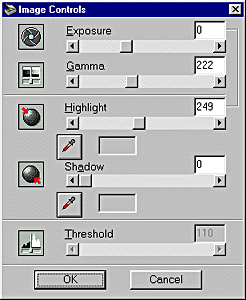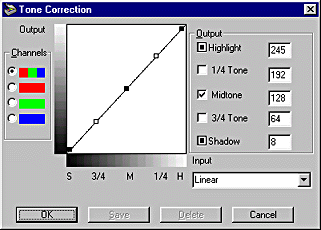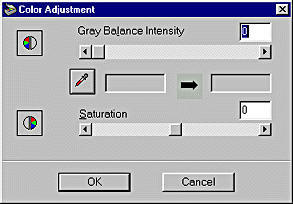|

Software Reference Guide
|
|
Understanding EPSON TWAIN Pro Features
Using the Adjust Buttons
 Auto Exposure
Auto Exposure
 Image Controls
Image Controls
 Tone Correction
Tone Correction
 Color Adjustment
Color Adjustment
 Reset
Reset
 Focus
Focus

Before you scan an image, you can make adjustments manually with the powerful image quality adjustment tools on the Preview window. The following adjust buttons are available.
Auto Exposure

Click the Auto Exposure button on the Preview window to automatically optimize the exposure for an image. The Gamma, Highlight and Shadow settings in the Image Controls dialog box are automatically set.
 |
Note:
|
 | -
The Auto Exposure button appears dimmed and is not available when the Pixel Depth is set to Black & White and AAS is not selected in the Image Type dialog box.
|
 | -
The Auto Exposure feature is automatically activated when scanning without previewing.
|

[Top]
Image Controls

Click the Image Controls button on the Preview window to view the following dialog box.

 |
Note:
|
 | -
The Image Controls button appears dimmed and is not available when TET (Text Enhancement Technology) is selected in the Image Type dialog box.
|
 | -
The Image Controls settings are optimized automatically when you scan without previewing.
|
 | -
If Pixel Depth is set to Black & White and Halftone is set to None in the Image Type dialog box, all the settings except Threshold appear dimmed and cannot be selected.
|
 | -
You can see the effects of the Image Controls settings in the Preview window.
|
Exposure:
The Exposure setting lightens or darkens an image. You can select from -10 (darkest) to 20 (brightest) by moving (clicking and dragging) the slider.
The Exposure and Highlight controls are related. When the Exposure setting is changed, the Highlight value is automatically set.
Gamma:
The Gamma control allows you to adjust the mid-tones in an image. You can select from 50 (darkest) to 500 (brightest) by moving the slider.
Highlight:
The Highlight control allows you to adjust the brightness level of the brightest parts of an image. You can select from 61 to 490 by moving the slider.
Click the eyedropper button beneath the slider, and the mouse pointer changes to an eyedropper. Move the eyedropper over the preview image, and click a bright area. The eyedropper "picks up" the color from that area, and uses it as the highlight for the entire image. This effect appears immediately in the preview image. Click Cancel to restore the original image.
Shadow:
The Shadow control allows you to adjust the darkness level of the darkest parts of an image. You can select from 0 to 60 by moving the slider.
Click the eyedropper button beneath the slider, and the mouse pointer changes to an eyedropper. Move the eyedropper over the preview image, and click a dark area. The eyedropper "picks up" the color from that area, and uses it as the shadow for the entire image. This effect appears immediately in the preview image. Click Cancel to restore the original image.
Threshold:
Available only when Pixel Depth is set to Black & White and Halftone is set to None in the Image Type dialog box. The scanner scans gray shades as either black or white using this setting.
You can select from 0 (lightest) to 255 (darkest) by moving the slider.

[Top]
Tone Correction

Click the Tone Correction button in the Preview window to view the following dialog box.

 |
Note:
|
 | -
The default Tone Correction settings are the Linear.
|
 | -
The Tone Correction button appears dimmed and is not available when Pixel Depth is set to Black & White, Halftone is set to None, and TET (Text Enhancement Technology) is selected in the Image Type dialog box.
|
 | -
You can see the effects of the Tone Correction settings in the Preview window.
|
The tone value represents the contrast in the tonal relationship between an original image and its reproduction on a monitor or printer.
Tone Curve editor:
The editor allows you to customize tone correction. Drag points on the tone curve to adjust the tone value. You can edit up to five tonal elements.
Output options:
If you select the check box for a specific point, such as 1/4 Tone or Midtone, you can move that point and it will remain where you leave it; it will not be affected by the movement of other points on the curve. If the check box is cleared, the point will be affected by the movement of other points.
Channels options:
You can select the combined red, green, and blue (RGB) channel to modify all colors, or select these colors separately.
 |  |
Note:
|
 |  |
If Pixel Depth is set to Black & White or 8-bit Gray in the Image Type dialog box, you can only select the combined RGB channel option.
|
Tone correction list:
Select a tone correction setting from this list. The custom settings you have saved appear in this list.
OK/Save/Delete/Cancel buttons:
To accept the defining Tone Correction or close the dialog box,
click OK.
After you correct tone, type a name for your custom settings in the tone correction list and click Save.
To delete a setting, select the name of the setting you want to delete in the tone correction list and click Delete.
To cancel the operation, click Cancel.

[Top]
Color Adjustment

Click the Color Adjustment button in the Preview window to view the following dialog box.

 |
Note:
|
 | -
If Image Type setting is not Color Photo or Color Photo De-screening, or Pixel Depth is set to 8-bit Gray or Black & White, the Color Adjustment button appears dimmed and these settings cannot be selected.
|
 | -
You can see the effects of the Color Adjustment settings in the Preview window.
|
Gray Balance Intensity:
Gray Balance Intensity removes unwanted color casts and tints by balancing color saturation.
Click the eyedropper button beneath the slider. The mouse pointer changes to an eyedropper. Then click the color you want to represent gray. The eyedropper "picks up" the color and displays it in the box beside the eyedropper button. You can then correct the cast level for that color from 0 to 100 by moving the slider. The corrected color appears in the box on the right, and the effect shows up immediately in the preview image. Click Cancel to restore the original image.
Saturation:
Saturation is the property that defines color depth. Select a saturation level from -100 (less color) to 100 (more color) by moving the slider.

[Top]
Reset
Use the Reset Button to return any image control settings you made back to their default settings. If you did not alter any image control settings, this button appears dimmed and is not available.

[Top]
Focus

Click the focus button on the Preview window to set the focus position to either 2.5 or 0.0. The setting is indicated under the button.
If TPU (for Neg. Film or for Pos. Film) is selected as the Document Source, the value of the focus position is automatically set to 2.5. If you set the film to be scanned using film holders, you do not need to change the focus setting. If you set the film directly on the scanner's document table, it is recommended to change the focus position to 0.0.
If Flatbed or ADF (Single-sided or Double-sided) is selected, the value is automatically set to 0.0. It is recommended not to change the setting unless you want to have the scanned images out of focus or want to scan an object that is not flat.

[Top]
| Version 1.00E, Copyright © 2001, SEIKO EPSON CORPORATION |
Auto Exposure
Image Controls
Tone Correction
Color Adjustment
Reset
Focus